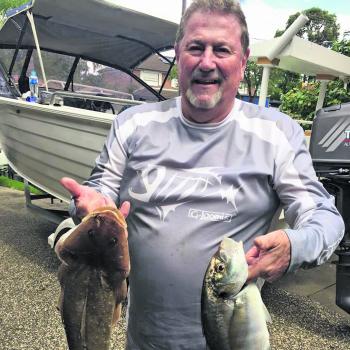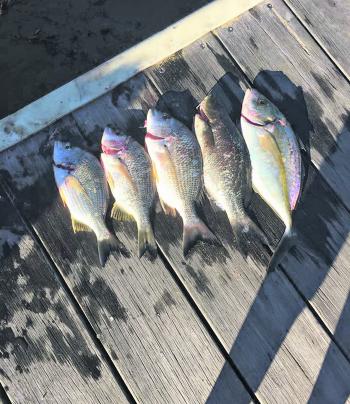Reports indicate a vast improvement on the fishing scene during the past month. Schools of big bream have congregated on the sand and weed corridors between Towra and Bonna Point with fish around the 40cm mark not uncommon.
This is customary for this time of year and judging by the catches that have filtered through, a good season is expected. The best method I’ve found to catch these is by anchoring on the edge of weed and casting into the sand. Berley and patience are a must as the fish take a little time to respond to the enticing chicken or prawn pellets.
A simple split shot is needed just behind the hook, as there’s little tidal movement in this area. Leave your bail arm open or use a small bait and 3kg monofilament. If using braid, a similar rig applies, but with at least a 2m trace of similar weight fluorocarbon. The bream do not normally muck around and take the bait readily. Stick to locally pumped pink nippers as your number one bait on a size 2 longshank baitkeeper hook – you’ll be rewarded.
Bloodworms work extremely well in this area, with the added bonus of picking up good size whiting as well. The best times are usually during the first few hours of daylight, especially if there’s a big high tide and the last couple of hours before dark under similar conditions.
A few possies that should produce the goods this month are: the ‘Logs’, named after the logs on the shoreline just around the corner from Towra Point, approximately 500m out from the beach during a making tide, and the ‘Patches’ where Towra Beach meets the mangroves, approximately 500m out in the 4-5m of water – patches of sand and weed dot the area. Rising tide is best here with the added bonus of flathead and jackets.
The Yellow Tidal Gauge Buoy is anther top spot easily found. Just anchor anywhere near the marker, berley up and the fish will find you. Towra wide – best during the last three hours of the run out tide by day for big tarwhine, bream, whiting, trevally and flathead. This spot is easily found by lining up the red channel markers, 300m wide of Towra Point itself.
Kingfish up to 80cm have made an early appearance and have been consistently taken along the Port Botany Reclamation Wall. The best method by far has been by downrigging fresh strips of local squid, whole live squid and live sea-going yellowtail. These fish are not going to jump in the boat and you need a good sounder to locate the schools. It’s all worth it when a few are boated near the Foreshore St Boat Ramp.
Other possies which have been firing include the markers around both runways, the artificial reefs in Congwong Bay and Yarra Bay and along the rocky cliffs between Cape Banks and Long Bay. A word of warning – if you’re going to chase these marauders, make sure you’re using at least 50lb braid as main line and 80lb fluoro leader, otherwise you’re fighting an uphill battle.
Flathead have been very consistent with plastics providing the better catches. The 70mm Squidgy grasshopper coupled with a 1/0 hook jighead has been the standout lure, but the usual black and gold or Gary Glitter paddlers in the 50mm class will do the job beautifully.
If using bait, stick to a running sinker rig with a sinker heaver than normal, so it creates awareness when bouncing on the bottom – a yellow twin tail Mister Twister placed above a 2/0 longshank hook is ideal, then a nice size Hawkesbury prawn will finish the job. Make sure you take the tail off the prawn and pinch the head, which will release all the flavour.
Areas which have been fruitful include the ever-popular drift form the Kurnell Oil Wharf to Towra – this drift is excellent during a northeasterly influence and making tide with the added bonus of picking up a school mulloway. Make sure you set your witches hats for blue swimmer crabs, as they’re plentiful this time of year. Other drifts include the entrance to the Georges River from Dolls Point to Ramsgate approximately 300m out and the drift between the old runway and the Novotel at Brighton.
Whiting have been a little scarce, but when you’re lucky to spot a school, they’re usually of a good size. Unless you’ve got some bloodworms, you’re wasting your time. Land-based, give La Perouse Beach on top of the tide, the weed patches along the Grand Parade at Brighton-Le-Sands, and along the gutters of Kyeemagh Beach. If in a boat, you could do worse than anchoring in front of the boat ramp at Kurnell in 4-5m and you’ll get a few.
Trevally are still around in good numbers and provide great sport on light gear. They’re bigger than in previous weeks averaging 35-40cm and can be easily caught in berley around the boat with bread. The artificial reefs have proved a Mecca for these blurters with plenty of food available. I’d suggest 50m out from N°157 on Molineaux Point, the red buoys along the shipping channel in front of the Port Botany Retaining Wall, Sutherland Point drop off and the eastern side of the oil wharf near the round drum. This is an excellent spot this time of year and any species can be caught. These wharfs are blessed with small reefs, gravel patches, shoals and other natural attractants.
Tailor and salmon are still available for the small boat brigade with small Raider lures the best option. Simply spot the birds then cast into the schools and hang on. The best areas have been around Bare Island, Henrys Head on the north side and the stretch between Yena and Tabbigai in the south.
The offshore scene has had mixed results, and as can be appreciated, the weather dictates plans for the outing. The 12 mile reef has been hot and cold, but I have it on good authority that the big Chinaman jackets are destroying tackle, so make sure you take plenty of wire rigs. If you can get past the jackets, then there’s a good chance to pick up a longfin perch, which in my book is one of the most beautiful fish as well as excellent easting. The trick in catching these is to use a heavier sinker and lace leader as close to the sinker as possible. This method will allow you to get past the jackets, as they normally school a few meters from the bottom. Baits like mackerel and tuna are best.
Kingfish are a day-to-day proposition, but they’re there in reasonable numbers. The new Shimano Ocea jigs with horizontal bars in yellow, black or burgundy are sensational and they’ve been accounting for the better catches. A few mahi mahi have been taken by trolling skirts, but they’re not being taken around the FADs.
The Peaks have trevally and leatherjackets on the chew and the best method is to anchor on the 65m Pinnacle and berley the fish around. There are also a few small mako showing up and they can be enticed with strips of tuna, whole squid or other baits.
The close grounds have not been congenial as expected – the Masons, the Tank of Maroubra, Saxons and Mistral Point have only yielded the odd mowie or red. Blue spot flathead are still about in good numbers and can be taken from the sand contours in 40m between Botany Heads, the 46m mark in front of Cape Bailey and the 38m mark due east of Marley Beach.
The boat ramp at Oatley Bay has finally been reopened following a four month closure for refurbishing, and after a close inspection it looks a picture, and will provide much needed parking to the lower reaches of the system. While the River Road ramp at Revesby Beach has been a good standby, the jet skiers frequenting this ramp have not made the job easier in launching boats. I’m told by Maritime that on-water cameras will be placed in strategic locations to check personal watercraft speed and make sure they meet the speed requirements.
Medium size 32-35cm whiting have been taken at night on the stretch between Milperra Bridge and Rabaul Road Boat Ramp. Bob Dean has been the architect of catches picking up his six fish per outing on locally pumped squirt worms. School Mulloway have also been on the prowl, taking live herrings under the M5 Freeway Bridge with fish around the 4kg mark. Similar catches have been reported from the East Hills Railway Bridge. The top of the tide appears to be the best time.
Trevally around the 40-45cm mark are scattered throughout the system and readily taking live nippers, bloodworms and peeled prawns. Good numbers are available at Kangaroo Point on the making tide, the crack in the wall at Oatley Bay, the Caravan Head channels, the Eagle Nest Post at Crabrook and the Moons.
Luderick catches are down slightly, but the regular fishos are still going home with a feed. The feeding pattern has changed slightly and it may pay to alter your location for better catches. I’m told the public pontoon next to the boat ramp is fishing well for fish around the 32-34cm mark. A good idea would be to berley with sand and weed there. The old ferry wharf on the other side of Lugarno Seafood Restaurant, northern side of Tom Uglys Bridge, Black Butt and Mickeys Point are all good.
If you need green weed, please contact the writer on 4647 8755, we’ve always got ample quantities of local weed.
Bream have been disappointing with many fish around the 25/27cm about. Although they are legal, they’re probably too bony to eat, however when things are tough, they provide a feed to take home.
You’ll find them around most channel markers in the system, reefs, structures, cockle beds, under moored boats and sunken walls. Jewfish Point, the boat shed above Como Bridge, Soily Bottom, the entrance to the Woronora River are all likely possies. Flathead have been taken by drifting in the middle of the river.
Good sized dusky flathead will take lures dangled in front of them, but make sure you use a yo-yo action for best results. They’re being caught between Lugarno and Griffin Point, Jewfish Point to Como Bridge, between Captain Cook and Tom Uglys bridges.
If you fancy a spot of freshwater fishing, look no further than the Nepean River at Mauldeen, near the concrete works. Bass around 40-43cm have been taken on worms, while Cobbity Weir and the footbridge at Eldersue have produced the odd good fish. Near Penrith at Tench Reserve and Glenbrook Gorge, Ecogear vibes have accounted for a few fish.
There are trout in Norton Basin, which are unable to get out to the main system. We don’t know how long they’re going to be alive as the water is warming up. All in all, things are starting to hot up, so let’s hope the weather stays on our side with a feed.
Reads: 3839
Some land-based whiting caught by Bob Dean in the Georges River.

The author with a couple of specimens from a recent mixed bag.

Pedragi with a Port Kembla lizard.





